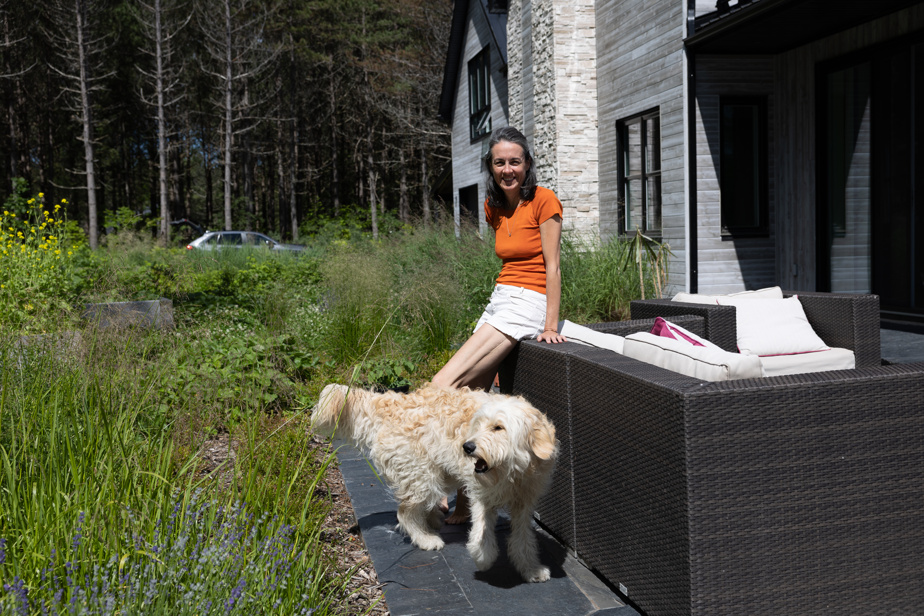Magali Duburcq and Arnaud Douilliez met in their native France, lived seven years in Belgium, but it is in the Eastern Townships, in Orford, that they take root with their three children. The land where they had their ecological house built two years ago is changing at a pace that surprises them, thanks to their desire to let nature take over.
Posted at 12:00 p.m.
The house, built aiming for LEED certification, stands in the middle of an old pine forest, planted about forty years ago. “There were pines through which nothing grew,” explains Magali Duburcq. It was a monoculture and we tried, around the house, to revive an ecosystem by growing completely different varieties. The soil was very acidic and the vegetation had to be given a helping hand. »
The couple turned to landscape architect Stéphanie Desmeules. “You had to tick off certain prerequisites in order to obtain LEED certification, such as choosing plants that need little water, using little or no backfill, keeping as much as possible of what there is on the ground to avoid transport, select local materials, explains the latter. For the patio and paths, we opted for local slate. We have beautiful quarries in Quebec that offer materials of different colors. »
Bringing back biodiversity was an issue, and the owners were very open and very sensitive to this issue, specifies Ms.me Desmilles. “The monoculture had made it possible to see very far between the trunks,” she says. Many large shrubs and small trees were planted at the edge of the street to prevent people from having a direct view of the house, and 150 varieties of plants, shrubs, perennials and trees were planted around the home. Everything had to be indigenous, edible or have certain medicinal properties, to make herbal teas, for example. »

PHOTO MARTIN TREMBLAY, THE PRESS
Magali Duburcq is surprised to see how quickly the environment around her home is changing. The fruit and vegetable harvest is already abundant.
The planting was done in the spring of 2021. In the second summer, Magali Duburcq cannot believe the speed with which nature has reclaimed the land.
It doesn’t look like there was human intervention. We let everything grow back in a completely natural way. I find it magnificent, because it brings authenticity.
Magali Duburcq
“Often, the gardens are sanitized. Everything is clean. It’s very beautiful, but it’s very cold. While there, it’s an invitation to relax, to tell yourself that a plant can grow all crooked while remaining beautiful and attractive, she adds. This gives us the ability to go all out and not always have to be perfect. »
-

PHOTO MARTIN TREMBLAY, THE PRESS
The house, built aiming for LEED certification, stands in the middle of an old pine forest, planted about forty years ago.
-

PHOTO MARTIN TREMBLAY, THE PRESS
The plants have been chosen with care. Everything that has been planted grows back naturally.
-

PHOTO MARTIN TREMBLAY, THE PRESS
The plants chosen had to be native, edible or have certain medicinal properties, to make herbal teas, for example.
-

PHOTO MARTIN TREMBLAY, THE PRESS
A local slate was chosen for the terrace.
-

PHOTO MARTIN TREMBLAY, THE PRESS
All the members of the family feast among other things on the strawberries that grow in the field.
-

PHOTO MARTIN TREMBLAY, THE PRESS
Bringing back biodiversity was an issue, and the owners were very sensitive to this issue.
1/6
Desire to give back
Stéphanie Desmeules won the Habitat Design Prize, Landscape Architecture 2021, for transforming the site into a living and nourishing space. However, she had almost left the profession after the death of her husband, also a landscape architect. During his illness, the couple got very close to nature, in Saint-Denis-de-Brompton, in the Eastern Townships. “I found myself as a single parent, with three children, and I no longer had the desire to find the rhythm of before, in an office, reveals Ms.me Desmilles. I needed my community during my spouse’s illness and I wanted to give back to my neighbour. »

PHOTO PROVIDED BY STÉPHANIE DESMEULES
Landscape architect Stéphanie Desmeules believes in mutual aid and cooperation. She found her calling by seeking to help the environment and humans.
She found her way by seeking to help the environment and humans, using the research she conducted on the benefits of nature on the health of sick and vulnerable people. She designs landscapes for schools, care homes and businesses. It also has a residential clientele. Believing in mutual aid and cooperation, it offers various discounts to individuals and organizations that share the same values as it.
“People who come to see me don’t have the car of the year,” she explains. They really have an ecological conscience, which goes through the sensitivity of living together and sharing. They like to interact with their neighbours, pass on their tips, share their gardening tools, and learn from each other. »
It’s another way of living, having the feeling of being able to rely on others. This philosophy is widespread in the Eastern Townships.
Stephanie Desmeules

PHOTO MARTIN TREMBLAY, THE PRESS
Around 150 varieties of plants, shrubs, perennials and trees have been planted around the house.
This generosity appealed to Magali Duburcq, who is very involved in Orford, where she set in motion a mutual aid movement, in particular through the Facebook page Abondance Orford.
“I also liked that she went to look for a more spiritual, energetic side of the plant and of everything that is invisible, and yet has an impact in the physical world,” she continues. We didn’t go looking for aesthetics, but in the end we find it, because we let life decide. It’s much more powerful than when it’s the human who decides. »

